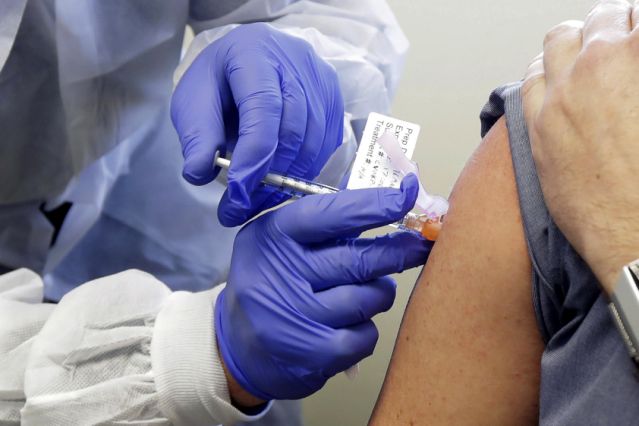Is that even possible?
By Andrew Romano, Yahoo! News
The hardest-hit parts of the United States may be past the peak of the pandemic. Other places may be lifting their lockdown restrictions. But deadly pathogens don’t eradicate themselves; once Americans stop staying home, the coronavirus will continue to spread.
The expectation is the U.S. won’t return to normal until there’s an effective vaccine against COVID-19 — and almost everyone in the country has been vaccinated.
When and how that will occur has been the subject of speculation since the start of this crisis. But in recent days that chatter has intensified amid the news that Oxford researchers might have an effective vaccine ready by September and reports that President Trump has ordered a “Manhattan Project-style effort” called Operation Warp Speed that aims to inoculate almost all Americans by year’s end.
But can the U.S. really rush-release a COVID-19 vaccine this year? To understand how unprecedented that challenge is — and what the odds of overcoming it actually are — you need to understand a few key numbers.
300 million: The number of doses of COVID-19 vaccine that Operation Warp Speed reportedly aims to deliver in the U.S. by January 2021, according to Bloomberg News. The plan is to mobilize pharmaceutical companies, government agencies and military researchers to streamline and accelerate the conventional process of developing, testing, approving, regulating and licensing a vaccine.
12 to 18: The number of months Dr. Anthony Fauci, the nation’s top infectious disease expert, had previously estimated it would take to complete this process.
Four: The number of years it took, back in the 1960s, to bring a mumps vaccine to market. No vaccine has ever been released faster. For comparison, it took 28 years to deliver the varicella vaccine; 28 years to release FluMist; 15 years for the HPV vaccine; 15 years to deliver the rotavirus vaccine; and 11 years for the first pediatric combination. A vaccine for the Ebola virus that went into clinical trials in 2014 only just received approval from U.S. regulators in December — a five-year effort considered remarkable for its speed. “When Dr. Fauci said 12 to 18 months, I thought that was ridiculously optimistic,” Dr. Paul Offit, the co-inventor of the rotavirus vaccine, recently told CNN.
Eight: The number of months between now and January 2021. On Wednesday, Fauci shortened his most “aspirational” timeline, telling NBC’s “Today” show that January is “doable if things fall in the right place.”
“I mean, I’m obviously part of the team that’s involved in that,” Fauci added.
102: The number of coronavirus vaccines now in development, according to the World Health Organization.
Eight to 10: The number of those potential vaccines that “look particularly promising,” according to Microsoft founder Bill Gates. Gates’s philanthropic foundation has spent several decades (and tens of billions of dollars) strengthening the global health system. He is now investing billions more to help seven makers of possible coronavirus vaccines start developing facilities and manufacturing doses before any one of them is approved by the Federal Drug Administration (FDA).
Roughly 80 percent: The amount of genetic overlap between SARS and SARS-CoV-2, the official name of the coronavirus that causes COVID-19.
This is important — and encouraging — because the first step in developing a successful vaccine is identifying one that’s potentially effective. Unusually, scientists at Oxford’s Jenner Institute have already done that, with the advantage of a head start. By the time news broke in January that Chinese scientists had identified the genetic code of a mysterious virus in Wuhan, the Oxford team was already developing a vaccine against a similar coronavirus (Middle East respiratory syndrome, or MERS) and proving its safety. It immediately switched over to SARS-CoV-2.
Six: The number of rhesus macaque monkeys inoculated with single doses of the Oxford vaccine in March at the National Institutes of Health’s Rocky Mountain Laboratory. The first step in a conventional trial is to test a vaccine on animals to see if it works. In Montana, all six of the monkeys were exposed to heavy quantities of SARS-CoV-2 — exposure that had “consistently sickened other monkeys in the lab.”
Six: The number of inoculated rhesus macaque monkeys that were still healthy more than 28 days later.
Three: The number of phases required for a conventional clinical trial.
Phase I tests for safety by giving a small group of healthy volunteers different dosages; the goal is to create the strongest immune response at the lowest effective dose — without serious side effects.
Phase II tests that dosage on a larger group of volunteers — typically hundreds of people of various ages and levels of health — to make sure they develop the proper antibodies.
Phase III pits the vaccine against a placebo by giving both to thousands of volunteers, who then go about their daily lives. If after a long time the vaccinated group turns out to be less likely to get sick than the placebo group (in a statistically significant way), the vaccine is deemed effective. Licensing and production follow.
Again, this process has never taken less than four years from start to finish.
1,100: The number of volunteers participating in Oxford’s phase I clinical trial, which began last week. “Armed with safety data from their human trials of similar vaccines for Ebola, MERS and malaria,” reported the New York Times, “scientists at Oxford’s institute persuaded British regulators to allow unusually accelerated trials while the epidemic is still hot around them.” This trial should determine whether the fast-tracked vaccine will trigger serious problems or side effects.
The biggest worry is disease enhancement, a boomerang effect in which the vaccine not only fails to offer protection, but can also lead to a more severe disease. During the Ford administration, a rushed vaccine for swine flu caused several dozen deaths and damaging side effects.
5,000: The number of volunteers slated to participate in Oxford’s combined phase II and phase III trial later this month. Early readouts of Oxford’s human trials will become available in May, and researchers “hope to get some signal about whether it’s working by the middle of June,” John Bell, a professor of medicine at the University of Oxford, told the BBC’s “Today” radio program Thursday. While other teams in China and Germany are currently conducting phase I and phase II trials, only Oxford is ready to test for effectiveness.
But that raises an important question: How effective does a COVID-19 vaccine need to be? What’s the goal here?

Around 45 percent: The measured effectiveness of this year’s flu vaccine, according to the U.S. Centers for Disease Control and Prevention.
70 percent: The effectiveness likely required of COVID-19 vaccine in order “to stop the outbreak,” according to Bill Gates.
“Although you’d ideally want a vaccine to have 100 percent efficacy, many don’t,” Gates wrote Thursday. “A 60 percent effective vaccine is usable, but we might still see some localized outbreaks. Anything under 60 percent is unlikely to create enough herd immunity to stop the virus.”
One or two: The threshold number of cases that will determine the effectiveness of the Oxford vaccine in its upcoming trial. If no more than two of the participants who received the vaccine become sick, compared with an expected dozen in the placebo group, “then we have a party and tell the world,” the director of Oxford’s Jenner Institute told the Times.
But that’s the best-case scenario.
Less than 10 percent: The share of all drugs in clinical trials that later end up getting FDA approval. The rest are declared ineffective or unsafe. Also, no one has ever created and released a successful human vaccine for any of the other coronaviruses in circulation, including several that cause the common cold.
40 years: The amount of time scientists have been trying — and failing — to develop an HIV vaccine. The best they’ve done? A few phase III trials. One made the disease worse. Another had a success rate of just 30 percent.
But assuming the Oxford vaccine — or the German vaccine, or the Chinese vaccine, or another vaccine, or more than one of the above — actually works and isn’t dangerous, how would the Trump administration ensure that all Americans can get vaccinated? Especially by January?

100 million: The number of doses of the Oxford vaccine that British drugmaker AstraZeneca is aiming to produce by the end of 2020, according to a partnership announced Thursday. Supply would be prioritized in the U.K., however — not the U.S.
Zero (so far): The number of U.S. drugmakers who have partnered with the Oxford team. Why no takers? “Because the major pharmaceutical companies [here] typically demand exclusive worldwide rights before investing in a potential medicine,” the Times explains. Meanwhile, “other scientists involved in the project are working with a half-dozen drug manufacturing companies across Europe and Asia to prepare to churn out billions of doses as quickly as possible if the vaccine is approved. None have been granted exclusive marketing rights.”
10 million to 20 million: The number of doses of a coronavirus vaccine being developed by Germany’s BioNtech that U.S. drugmaker Pfizer is aiming to produce by the end of 2020, its global head of vaccines said Thursday. Those doses would be earmarked for “emergency use” (i.e., for health professionals).
300 million: Again, the number of doses Trump reportedly wants to deliver in the U.S. by January 2021. Which is where Operation Warp Speed comes in. There are a few American companies who either have started or will soon start clinical trials on potential vaccines of their own. If those vaccines pan out perfectly or U.S. drugmakers strike partnerships with successful researchers overseas, and if Warp Speed works as planned — by indemnifying the major pharmaceutical and biotechnology companies from liability; by spending billions to pre-manufacture multiple candidate vaccines before their safety or efficacy has been proven; and by consolidating competing efforts into one huge, coordinated trial — then it’s theoretically possible that Trump’s plan could work.

It’s also possible — perhaps more possible — that it won’t, and that it will be “more harmful to set an unreasonably short deadline that might result in a faulty vaccine than to wait for one that is proved safe and effective,” as some officials are reportedly telling the president.
Still, no crisis has so demanded a “Manhattan Project-style effort” since the Manhattan Project itself. If executed safely and skillfully, Operation Warp Speed is almost certainly worth a try — assuming American officials keep one final number in mind.
7.8 billion: The current global population. “In order to stop the pandemic” — which doesn’t respect borders — “we need to make the vaccine available to almost every person on the planet,” Gates wrote Thursday. Only then will the world, the U.S. included, “be able to get back to normal—and to hopefully make decisions that prevent us from being in this situation ever again.”












